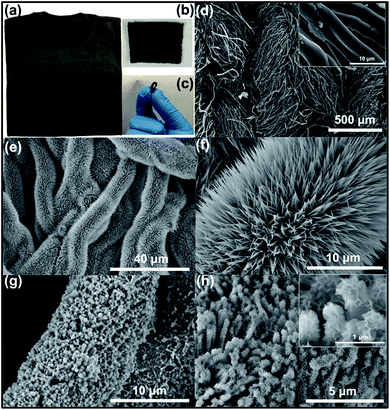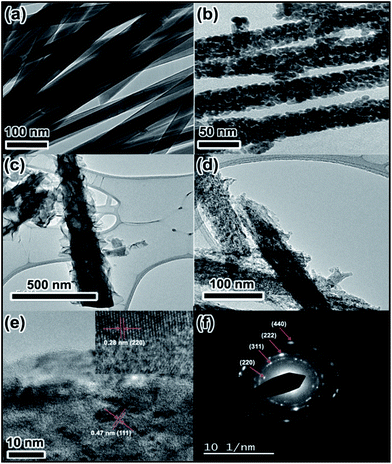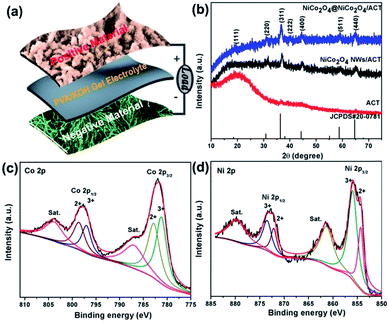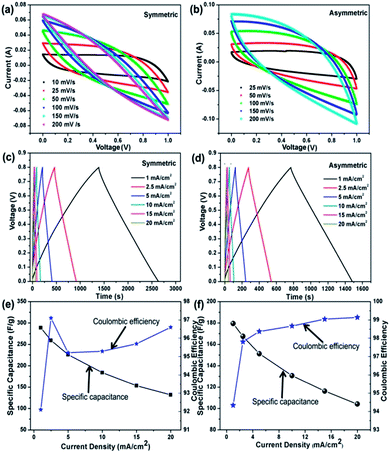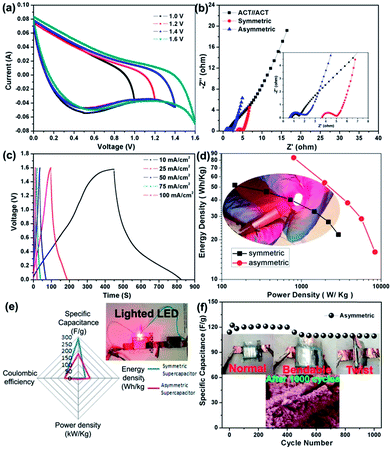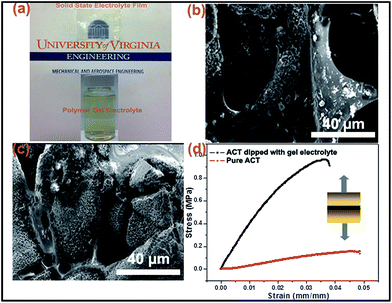Cotton textile enabled, all-solid-state flexible supercapacitors†
Zan Gao,
Ningning Song,
Yunya Zhang and
Xiaodong Li*
Department of Mechanical and Aerospace Engineering, University of Virginia, 122 Engineer's Way, Charlottesville, VA 22904-4746, USA. E-mail: xl3p@virginia.edu
First published on 27th January 2015
Abstract
A hierarchical NiCo2O4@NiCo2O4 core/shell nanostructure was grown on flexible cotton activated carbon textiles (ACTs) to fabricate NiCo2O4@NiCo2O4/ACT electrodes. After dipping with PVA/KOH polymer gel which served as both the solid state electrolyte and separator, the flexible NiCo2O4@NiCo2O4/ACT hybrid electrode exhibited an exceptional combination of electrochemical and mechanical properties in terms of specific capacitance (1929 F g−1, based on the mass of NiCo2O4), energy density (83.6 Wh kg−1), power density (8.4 kW kg−1), cycling stability, and mechanical robustness (the tensile strength is 6.4 times higher than that of pure ACT). The outstanding electrochemical performance is ascribed to the unique core/shell nanostructure with high active-surface area, morphological stability, and short ion transport path. Such hierarchical core/shell nanostructure of the same material on a cotton-enabled flexible substrate should inspire us to develop flexible solid-state textile energy storage devices for future wearable electronics.
1. Introduction
In modern society, energy is the lifeblood. To solve the issues of global warming, environmental pollution, and the depletion of fossil-fuel, a worldwide imperative is to make use of sustainable and renewable energy. Numerous energy storage solutions, for instance, mechanical, magnetic and chemical storage, are being intensively investigated to harvest renewable energy, such as solar, wind, geothermal and tidal energy.1 Batteries, fuel cells, and electrochemical capacitors that can convert chemical energy directly into electrical energy are the most effective technologies for practical electrochemical energy storage and conversion. Recently, supercapacitors (also known as ultracapacitors or electrochemical capacitors) have been regarded as one of the most promising energy storage devices due to their high power performance, long lifespan, and low maintenance cost.2 Most importantly, supercapacitors fill the power/energy gap between the traditional capacitors (with higher power density) and batteries/fuel cells (with higher energy density),3 and have shown a great potential in transportation, electrical power, electronics and aviation. Much effort has been devoted to developing lightweight, flexible, and highly efficient power devices to meet the urgent need of flexible/wearable electronics, such as flexible cell phones, roll-up and bendable displays, photovoltaic cells, artificial electronic skin, and distributed sensors.4However, previous research was mainly focused on aqueous solution, organic solution or ionic liquids, which usually brought serious package and safety problem.5–8 The possible leakage of highly toxic or corrosive electrolyte impedes its practical application in portable/wearable electronics.9 Solid-state supercapacitors, because of their combined advantages, such as small size, ease of handling, robust mechanical performance, excellent reliability and safety, wide operation temperature range and extended working potential, have attracted more and more attention.4 Flexible solid-state supercapacitors usually consist of flexible electrodes, solid-state electrolyte, flexible separator and packaging material. As the most crucial functional blocks, flexible electrodes have attracted considerable attention. For instance, carbon materials, such as carbon nanotubes (CNTs), carbon cloth, graphene papers, and carbon fibers, have been intensively investigated as the flexible electrodes duo to their higher power density, longer life cycle, outstanding mechanical robustness and excellent electrical conductivity.10–14 However, the use of expensive CNTs or graphene to construct flexible electrodes will increase the cost of the device. Another drawback of using CNTs or graphene is their relative low energy density. These two factors more or less hinder its widespread commercialization.
It is imperative to develop wearable energy storage systems for future flexible electronics. To date, however, textile based energy devices are still lacking. Streamlined manufacturing processes for integrating flexible energy storage devices with wearable electronics have not been truly realized.15 Cotton textiles are the most widely used natural fibers for soft and breathable clothing. In our previous work, we have successfully converted a commercial cotton T-shirt into activated carbon textiles (ACTs) with highly conductivity and flexibility for flexible energy storage application.16 By integrating ACTs with MnO2, the textile-based flexible supercapacitors exhibited remarkably enhanced electrochemical performance. To further improve the electrochemical performance of carbon based supercapacitors, pseudocapacitive materials (MnO2,17,18 NiCo2O4,19 Co3O4,20 NiO,21 LDH22 and conducting polymer23,24) have been used to decorate the surfaces of carbon materials. However, due to the poor conductivity and short ion diffusion path of pseudo-capacitive materials, the electrochemical reaction process happens only on the very surface layer of the electrode, which limits the contribution of the inner active materials to the total capacitance.25 To make full utilization of pseudocapacitive materials, an intelligent strategy is to compound two types of materials or nanostructures on one conductive substrate with integrated hierarchical architectures, which fully exploit the potential of individual materials and bring together many competitive advantages, such as rich electroactive sites, easy accessibility of electrolyte ions, short diffusion path, superior current collection efficiency and the fascinating synergetic effect of different components.26–29 For example, Zhang et al.30 reported enhanced electrochemical performance (areal capacitance of 2.04 F cm−2 at the scan rate of 5 mV s−1) from hierarchical Co3O4@NiCo2O4 nanoforest on Ni-foam. Daoping et al.31 achieved a specific capacitance of 14.67 F cm−2 from NiCo2O4@CoMoO4 core/shell nanowire arrays. Yu et al.32 demonstrated that NiCo2O4@MnO2 core/shell pseudocapacitors achieved a specific capacitance of 1.66 F cm−2. Recently we fabricated Zn2SnO4/MnO2 core/shell nanocables on carbon microfibers and NiCo2O4@NiO core/shell nanostructure on carbon cloth for high performance flexible electrodes.33,34 The drawback of the aforementioned core/shell structure is the high contact resistance between the core and shell which are dissimilar materials. It remains a great challenge to synthesize core/shell nanostructures of the same material due to the difficulties in controlling the assembly and fusion of the core and the shell with pre-designed morphologies.35
Recently, ternary nickel cobaltite (NiCo2O4) has been intensively studied as a high-performance electrode material for supercapacitors due to the exceptional combination of its high electrical conductivity and electrochemical activity. Several types of NiCo2O4 nanostructures including 1D nanowire,36 2D nanosheet37 and 3D urchin-like microsphere38 have shown great promise for supercapacitor applications. Although the capacitive performance of various nanostructures has been intensively investigated, there are rarely reports about the integration of hierarchical nanostructures comprised of the same material with different morphologies.
In this study, we synthesized hierarchical NiCo2O4@NiCo2O4 core/shell nanostructure on highly flexible and conductive activated carbon textiles (ACTs) which were converted directly from cotton textiles. The conductive NiCo2O4 nanowires, radially anchored on the ACT fibers, served as cores (backbones) to support the NiCo2O4 nanoflake shells to form a hierarchical 3D porous nanostructure of the same material. Such scaffold-like porous architecture served as a reservoir for electrolyte ions, providing highly electrolytic accessible surface area, robust electrical connection to substrate and short ion diffusion path. The nanowire core and nanoflake shell are of the same material, thereby eliminating the contact resistance between the core and the shell, enabling a fast reversible Faradaic reaction and full utilization of active materials during charge/discharge process. After dipped in polyvinyl alcohol (PVA)/KOH solid-state electrolyte, the interspace of the NiCo2O4@NiCo2O4 core/shell scaffold-like architecture was completely filled with gel electrolyte which concurrently served as separator, not only improving the accessibility of electrolyte ions but also intensifying the mechanical strength of the flexible electrode. The fabricated flexible NiCo2O4@NiCo2O4/ACT hybrid electrode achieved an exceptional combination of electrochemical and mechanical properties in terms of specific capacitance (1929 F g−1), energy density (83.6 Wh kg−1), power density (8.4 kW kg−1), cycling stability, and mechanical robustness (the tensile strength is 6.4 times higher than that of pure ACT). Such hierarchical core/shell nanostructure of the same material on cotton-enabled flexible substrate should inspire us to develop flexible solid-state textile energy storage devices for future wearable electronics.
2. Experimental section
2.1 Preparation of flexible NiCo2O4@NiCo2O4/ACT electrode
2.2 Characterization methods
The crystallographic structure of the synthesized materials were determined by a PANalytical X'Pert Pro Multi-Purpose Diffractometer (MPD) equipped with Cu Kα radiation (λ = 0.15406 nm). The microstructure of the samples was characterized by scanning electron microscopy (SEM; FEI Quanta 650) and transmission electron microscopy (TEM; Philips CM 200 FEG, 160 kV). X-ray photoelectron spectroscopy (XPS) measurements were performed using a PHI 5700 ESCA spectrometer with monochromated Al KR radiation (hν = 1486.6 eV). All the XPS spectra were corrected by the C 1s line at 284.5 eV.2.3 Fabrication and electrochemical characterization of flexible all-solid-state supercapacitors
The flexible supercapacitors were assembled with two pieces of flexible electrodes (2 cm × 1 cm) face-to-face separated by the solid-state polymer electrolyte. The PVA/KOH gel was prepared by mixing 3 g KOH and 6 g PVA in 60 mL deionized water and heated to 80 °C under stirring until the solution became clear. A flat Petridish was used to prepare a thin KOH/PVA film by a natural solidification process. Prior to assembly, the fabricated flexible electrodes were first dipped into the gel electrolyte for 3 min to ensure that the internal interspace of active materials was completely filled with the electrolyte. After solidified at room temperature, the solid-state flexible supercapacitor was fabricated with a KOH/PVA film by mechanical pressing. The KOH/PVA film served as both the separator and electrolyte.The electrochemical characterization was carried out using a CHI 660E electrochemical workstation. The comprehensive electrochemical properties of the as-obtained products and assembled flexible supercapacitors were investigated by both three-electrode and two-electrode electrochemical systems. For the three-electrode system, ACT, NiCo2O4 nanowire/ACT and NiCo2O4@NiCo2O4/ACT electrodes were directly used as the working electrode, a platinum foil (1 cm × 1 cm) and a saturated calomel electrode (SCE) were used as the counter and reference electrodes, respectively. The three-electrode tests were carried out in 6 M KOH aqueous electrolyte at room temperature. Cyclic voltammograms (CV), galvanostatic charge/discharge curves, and electrochemical impedance spectroscopy (EIS) in the frequency range from 100 kHz to 0.05 Hz with an AC perturbation of 5 mV were used to evaluate the electrochemical performance of the flexible electrode. Asymmetric and symmetric flexible cells were also assembled by using ACT, NiCo2O4 nanowire/ACT and NiCo2O4@NiCo2O4/ACT as the flexible electrodes, conductive copper tape attached on the PET film as current collectors, and the as-made solid-state polymer PVA/KOH gel film severed as both the separator and electrolyte sandwiched between the two electrodes. The total electrode masses (including ACT) are 11.12 mg and 10.71 mg for the symmetric and asymmetric supercapacitors, respectively.
3. Results and discussion
3.1 Structural and morphological characterization
Fig. 1 shows the design wisdom and fabrication procedure of hierarchical NiCo2O4@NiCo2O4 core/shell nanostructure on ACTs. In a typical experiment, NiCo2O4 nanowire arrays were first radially grown on ACT fibers using a facile hydrothermal method, followed by a calcination process under argon protection (step i). The hydrothermally synthesized NiCo2O4 nanowire arrays then served as the backbone for the deposition of NiCo2O4 nanoflakes by a chemical bath deposition method (step ii). Such a hierarchical nanostructure (NiCo2O4 nanowire core/NiCo2O4 nanoflake shell) on conductive ACTs provides plenty of interspaces, which not only increase electrolyte ion accessibility but also short the transport path, jointly improving the electrochemical performance.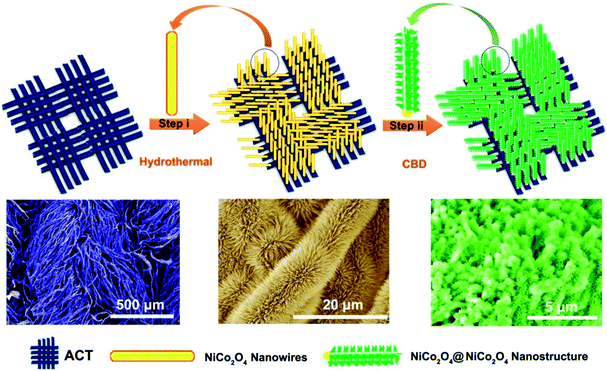 | ||
| Fig. 1 Illustration of the fabrication process of hierarchical NiCo2O4@NiCo2O4 core/shell nanostructure on activated carbon textiles (ACTs). | ||
The highly conductive and flexible ACTs were fabricated by direct conversion of a commercial cotton T-shirt through a dipping, drying and curing process as described in our previous report. Fig. 2a shows the digital photograph of a commercial cotton T-shirt, which was used to prepare ACTs. Fig. 2b shows the digital photograph of a piece of ACT, which is mechanically flexible even under folding state (Fig. 2c) and highly conductive (resistance ∼ 10–20 Ω sq−1). SEM image of ACT shows that the interwoven fibers of activated textile have the diameters ranging from 5 to 10 μm, which inherit the cellulose fiber architecture of cotton textile (Fig. 2d). Fig. 2e and f shows the morphology of NiCo2O4 nanowires hydrothermally grown on the surface of ACT. High-density of NiCo2O4 nanowires, with the length of several micrometers and diameter of around 70 nm, were radially aligned on individual ACT fibers, forming uniform nano-arrays with highly open and porous structure. After the coupled chemical bath deposition and following-up heat treatment, the surfaces of individual NiCo2O4 nanowires were uniformly decorated with NiCo2O4 nanoflakes (Fig. 2g and h). The cross-sectional and side-view images of the NiCo2O4@NiCo2O4 core/shell nanoarchitecture (Fig. 2h) jointly reveal that the tiny flaky NiCo2O4 nanosheets (<10 nm) were densely anchored on individual NiCo2O4 nanowires. Of importance, the nanowire core and nanoflake shell are of the same material NiCo2O4, thereby eliminating the contact resistance between the core and shell and ultimately enhancing both energy and power densities. The tiny NiCo2O4 nanoflakes render a highly porous hierarchical architecture, which serves as a reservoir for electrolyte ions, providing dense diffusion channels for energy storage.
The chemical compositions of the NiCo2O4 nanowire/ACT were further analyzed by energy-dispersive X-ray spectrometry (EDS) (Fig. S1 in the ESI†). The Ni–Co atomic ratio is 10![[thin space (1/6-em)]](https://www.rsc.org/images/entities/char_2009.gif) :
:![[thin space (1/6-em)]](https://www.rsc.org/images/entities/char_2009.gif) 19, which is close to the theoretical atomic ratio (1
19, which is close to the theoretical atomic ratio (1![[thin space (1/6-em)]](https://www.rsc.org/images/entities/char_2009.gif) :
:![[thin space (1/6-em)]](https://www.rsc.org/images/entities/char_2009.gif) 2) of NiCo2O4, indicating that the Ni–Co hydroxide precursors were entirely transformed into the NiCo2O4 after the heat treatment, which agrees well with the XRD result (Fig. 4b), conforming the ACT microfibers were uniformly covered by the NiCo2O4 nanowire arrays.
2) of NiCo2O4, indicating that the Ni–Co hydroxide precursors were entirely transformed into the NiCo2O4 after the heat treatment, which agrees well with the XRD result (Fig. 4b), conforming the ACT microfibers were uniformly covered by the NiCo2O4 nanowire arrays.
The structure and morphology of Ni–Co hydroxide precursors, NiCo2O4 nanowire/ACT and NiCo2O4@NiCo2O4/ACT hybrids were further investigated by TEM. As illustrated in Fig. 3a, the Ni–Co hydroxide precursor nanowires have smooth surface with a diameter of about 50 nm and plenty of mesopores with the size of 2–4 nm inside individual NiCo2O4 nanowires (Fig. 3b). Such internal active surface areas further enhance the pseudocapacitance. The mesoporous NiCo2O4 nanowires are anticipated to exhibit unusually high electrochemical properties because of the high density of active sites and short electron transport path.40 Clearly, such NiCo2O4 nanowires provide a unique backbone for the design of hierarchal nanoarchitecture with the goal to further push up the electrochemical properties. After the chemical bath deposition, the NiCo2O4 nanowires were elegantly wrapped with leaf-like NiCo2O4 nanoflakes, forming a core/shell hierarchical nanoarchitecture of the same material-NiCo2O4, with high porosity (Fig. 3c and d). Fig. 3e and f show the HRTEM image and SAED pattern of NiCo2O4@NiCo2O4 nanostructure. A grain boundary was observed between the core and shell, with the d-spacing of 0.47 nm for the core and 0.28 nm for the shell, indicating different growth direction. The different lattice direction and typical amorphous diffraction pattern (Fig. 3f) suggest that the NiCo2O4@NiCo2O4 nanostructure is a mixture of crystal and amorphous phases, indicating poor crystalline in good agreement with the XRD results.
The XRD patterns of the obtained ACT, NiCo2O4 nanowire/ACT, and NiCo2O4@NiCo2O4/ACT are respectively shown in Fig. 4b. The peak at about 21° was identified to be the amorphous carbon from ACTs. The diffraction peaks in the XRD patterns of NiCo2O4/ACT and NiCo2O4@NiCo2O4/ACT can be indexed to the (111), (220), (311), (511) and (440) planes of the cubic NiCo2O4 phase (JCPDS card no. 20-0781).41 No foreign peaks were detected, indicating that both of the core and shell are pure NiCo2O4. The diffraction peak of ACT at 21° is hidden in the relative intense diffraction peak (111) of NiCo2O4 at 19° of the XRD patterns of the NiCo2O4/ACT and NiCo2O4@NiCo2O4/ACT. The relatively weaker intensity of the NiCo2O4 peaks in the hybrid NiCo2O4/ACT and NiCo2O4@NiCo2O4/ACT indicates low crystallinity, which is beneficial for the improvement of specific capacitance.42 XPS measurements were performed to explore the chemical states and compositions of the as-prepared NiCo2O4@NiCo2O4/ACT hybrid (Fig. 4c and d). The cobalt 2p XPS spectra consist of two spin–orbit doublets at 781.9 eV and 797.8 eV, respectively, pointing towards Co2+ and Co3+, and two shakeup satellites at 786.9 eV and 803.8 eV (identified as “Sat.”) (Fig. 4c). Similarly, the nickel 2p XPS spectra consist of two spin–orbit doublets at 872.8 eV and 855.7 eV, resulting from Ni2+ and Ni3+, and two shakeup satellite peaks at 879.8 and 861.3 eV (Fig. 4d).43,44
3.2 Electrochemical performance
The CV curves of the ACT and NiCo2O4 nanowire/ACT hybrid at the scan rates of 5, 10, 25, 50, 75, 100 mV s−1 with the potential windows ranging from −0.2 to 0.5 V versus SCE in 6 M KOH aqueous solution can be found in Fig. S2a and c in the ESI.† The quasi-rectangular shape of CV curves for ACT (Fig. S2a†) indicates ideal electrical double layer capacitive behavior. The CV curve of the NiCo2O4/ACT hybrid shows a more complicated shape with two pairs of redox peaks, which correspond to Faradaic redox reactions of NiCo2O4 that can be expressed in the following equations.45| NiCo2O4 + OH− + H2O ↔ NiOOH + 2CoOOH + 2e− |
| CoOOH + OH− ↔ CoO2 + H2O + e− |
The calculated specific capacitances from the CV curves can be found in Fig. S2b and d in the ESI.† The specific capacitances of ACT electrode are 120, 85, 49.4, 33.1, 26.3, 22.3 F g−1 at the scan rates of 5, 10, 25, 50, 75, 100 mV s−1, respectively, while the specific capacitances of the NiCo2O4 nanowire/ACT are respectively 1679, 902, 550, 348, 301 F g−1 (based on the mass of NiCo2O4) at the scan rates of 10, 25, 50, 75, 100 mV s−1. The remarkably improved capacitance of the NiCo2O4/ACT results from the high pseudocapacitance of NiCo2O4 nanowires.46 The decay of specific capacitance with increasing scan rate is due to the slow current accumulating process at low scan rates, which enables full access of active pores/sites, corresponding to its pseudocapacitive feature. Overall, the ACT electrode shows better rate performance while the NiCo2O4 nanowires possess high specific capacitance. The coupling of the ACT and NiCo2O4 nanowires renders the NiCo2O4 nanowire/ACT electrode higher electrochemical performance.
Fig. S3a† shows the CV curves obtained from the NiCo2O4@NiCo2O4/ACT electrode in 6 M KOH aqueous solution within the potential range of −0.2 to 0.5 V (vs. SCE) at different scan rates. Two pairs of peaks were found in each individual CV curve, indicating that the capacitance is mainly based on the Faradaic redox reaction. The well-retained shape of CV curve with an increase in scan rate suggests that the porous nanostructure of NiCo2O4@NiCo2O4/ACT hybrid electrode is indeed beneficial to the fast redox reaction. Furthermore, it is evident that each curve at different scan rates keeps similar redox couples, indicating the quasi-reversible and continuous Faradaic redox during the charge/discharge processes. The galvanostatic charge/discharge curve (Fig. S3b†) of the NiCo2O4@NiCo2O4/ACT electrode at a low current density (1 mA cm−2) exhibits two voltage stages which result from the pseudocapacitive feature of the electrode, agreeing well with the aforementioned CV study. The specific capacitances of the NiCo2O4@NiCo2O4/ACT hybrid electrode were calculated to be 1929, 1764, 1367, 1046, 771 and 576 F g−1 from the discharge curves at the current densities of 1, 2.5, 5, 10, 15 and 20 mA cm−2, respectively (Fig. S3c†). The well-defined hierarchical NiCo2O4@NiCo2O4 core/shell nanostructure increases the exposed active surface area for electrolyte and provides an express-path for the diffusion of electrolyte ions, leading to the high mass specific capacitance. The small equivalent series resistance (ESR) (0.27 Ω) and charge-transfer resistance (Rct) (3.61 Ω) obtained from the Nyquist plots of electrochemical impedance spectra (EIS) (calculated by the method given in ref. 47) of the NiCo2O4@NiCo2O4/ACT electrode are supportive of the remarkable electrochemical performance.
The CV curves and Nyquist plots of the ACT, NiCo2O4 nanowire/ACT and NiCo2O4@NiCo2O4/ACT electrodes are comparatively shown in Fig. S4 in the ESI.† The CV curve of the ACT shows electrical double layer characteristics with a rectangular shape, while the CV curves of the NiCo2O4 nanowire/ACT and NiCo2O4@NiCo2O4/ACT electrodes exhibit typical pseudocapacitive features with two pairs of redox peaks (Fig. S4a in the ESI†). Compared with the ACT and NiCo2O4 nanowire/ACT electrodes, the larger integrated area of the current–potential curves (Fig. S4a†) and reduced charge-transfer resistance (Fig. S4b†) of the NiCo2O4@NiCo2O4/ACT hybrid electrode indicate improved electrochemical performance, which is attributed to the intriguing hierarchical core/shell architecture with a plethora of internal mesopores, facilitating both mass and ions transport during the charging/discharging process. Long lifespan is a key factor for evaluating the practical application of supercapacitor electrode. Fig. S5† shows the cyclic performance of the NiCo2O4@NiCo2O4/ACT hybrid electrode conducted by the galvanostatic charge/discharge tests at a current density of 20 mA cm−2 for up to 1000 cycles. The NiCo2O4@NiCo2O4/ACT hybrid electrode exhibits a high specific capacitance and eminent cyclic stability with an increase of capacitance for the initial 50 cycles and 3.98% increase after 1000 cycle tests, which are ascribed to the full exposure of active Ni and Co sites to the electrolyte after the repetitive charge/discharge. The results obtained from the three electrode test system jointly show that the NiCo2O4@NiCo2O4/ACT is an exceptional supercapacitor electrode material in terms of high specific capacitance, excellent rate performance, long lifespan and low charge transfer resistance.
However, the three-electrode configuration could not fully reflect the real electrochemical performance of an electrode in real-world applications, because only one electrode contains the test material and the applied voltage and charge transfer across the single electrode are markedly different from the two-electrode configuration.48 To examine the practical performance of the NiCo2O4@NiCo2O4/ACT in a packaged cell, we assembled both symmetric and asymmetric flexible supercapacitors. Here ACT was chosen as the negative electrode to assemble a NiCo2O4@NiCo2O4/ACT//ACT asymmetric supercapacitor, as illustrated in the inset of Fig. 4a. The CV curves of the NiCo2O4@NiCo2O4/ACT symmetric and asymmetric supercapacitors were collected at different scan rates, as demonstrated in Fig. 5a and b. The CV curves of both symmetric and asymmetric supercapacitors exhibit nearly rectangular shape at slow scan rates, corresponding to the excellent synergistic effect of double-layer capacitive ACT and pseudocapacitive NiCo2O4. However, with the scan rate increasing, the obvious deviation from rectangularity of the symmetric supercapacitor suggests higher charge transfer resistance and poor rate performance. The constant current charge/discharge curves of the symmetric and asymmetric at different current densities (1, 2.5, 5, 10, 15 and 20 mA cm−2) are shown in Fig. 5c and d. The charge/discharge curves for both the symmetric and asymmetric supercapacitors are almost symmetric with a small internal resistance (IR) drop, indicating a good electrochemical capacitive characteristic and superior reversible redox reaction. Rate capability and coulombic efficiency are two important factors for evaluating the power applications of supercapacitors. The corresponding specific capacitances for the symmetric supercapacitor are 288 F g−1 at 1 mA cm−2 and 131 F g−1 at 20 mA cm−2, showing 45.48% of capacitance retention after the current density was increased 20 times (Fig. 5e). The specific capacitances for the asymmetric supercapacitor are 179 F g−1 at 1 mA cm−2 and 104 F g−1 at 20 mA cm−2, respectively, and 58.1% of the capacitance is retained (Fig. 5f), suggest better rate performance of the asymmetric supercapacitor, agreeing well with the CV results. Compared with the symmetric supercapacitor, the asymmetric supercapacitor exhibited relatively “poor” capacitance performance, probably due to the practical capacitance mismatch of positive and negative electrodes. The initial coulombic efficiency values of the symmetric and asymmetric cells were calculated to be 92.01% and 94.3% at 1 mA cm−2, respectively. The coulombic efficiency of the symmetric cell quickly increased to the peak value of 97.16%, immediately followed by a decrease and then a slow increase with the increase of current density. For the asymmetric cell, the coulombic efficiency exhibited a fast increase at the initial stage and then a gradual increase up to 99.16%. The high coulombic efficiency helps enhance the energy utilization efficiency and promote electrochemical reversibility.
To further explore the potential of the asymmetric supercapacitor, the applied voltage was extended to 1.6 V (Fig. 6a). The asymmetric cell exhibited a stable potential window even at the high voltage window, which is essential for practical applications. Fig. 6c shows the GV curves of the asymmetric supercapacitor at different current densities. The asymmetric cell exhibited a high capacitance retention 60 F g−1. At the current density 100 mA cm−2, indicating excellent rate performance. The EIS tests were carried out for an in-depth understanding of the electrochemical behavior of the assembled symmetric and asymmetric flexible cells. The Nyquist plots of the ACT//ACT cell, NiCo2O4@NiCo2O4/ACT//NiCo2O4@NiCo2O4/ACT symmetric cell and NiCo2O4@NiCo2O4/ACT//ACT asymmetric cell are compared in Fig. 6b. In the high frequency range, the intercept of the semicircle with the real axis represents the equivalent series resistance (ESR), which includes the ionic resistance, the intrinsic resistance, and the contact resistance at the electrode/current collector interface.49 Clearly, the smaller ESR of the NiCo2O4@NiCo2O4/ACT//ACT asymmetric cell results from the hierarchical porous nanostructure of the NiCo2O4@NiCo2O4/ACT electrode, which facilitates the access of electrolyte ions to the active surface and shortens the ion diffusion path. A straight line close to 90° was found for the asymmetric cell in the low frequency range, indicating a pure capacitive behavior and low diffusion resistance of electrolyte ions in the core of the electrode.50
Energy density and power density are crucial factors for evaluating the practical application of supercapacitors. A good supercapacitor is expected to provide both high energy density and high capacitance at high charge/discharge rates. The Ragone plots of the all-solid-state flexible NiCo2O4@NiCo2O4/ACT//NiCo2O4@NiCo2O4/ACT symmetric cell and NiCo2O4@NiCo2O4/ACT//ACT asymmetric cell are shown in Fig. 6d. As the plots show, the values and trends of energy and power densities for both symmetric and asymmetric cells are similar. For the symmetric cell, the energy density decreases from 51.6 down to 23.3 Wh kg−1, while the power density increases from 144 up to 2943 W kg−1. Compared with symmetric cell, the asymmetric cell shows higher energy density of 83.6 Wh kg−1 at a high power density of 800 W kg−1, and remains 21.16 Wh kg−1 at the power density of 8.4 kW kg−1. Clearly, the asymmetric supercapacitor exhibits much higher power density than that of the symmetric cell. The comprehensive performances for both symmetric and asymmetric cells were compared in the radar plots in Fig. 6e, indicating the synergistic effects of ACT and hierarchical NiCo2O4 nanostructure.
A long cycling lifespan is another important requirement for supercapacitor applications. The cycle stability of NiCo2O4@NiCo2O4/ACT//ACT asymmetric cell was evaluated by repeating the constant current charge/discharge test under different states (normal, bent and twisted states) at a current density of 15 mA cm−2 for 1000 cycles (Fig. 6f). The asymmetric cell showed an increase in specific capacitance at the initial normal state, which is ascribed to the incomplete exposure of Ni and Co active sites to the gel electrolyte. There is almost no specific capacitance loss after 1000 charge/discharge even at the bent and twisted states, indicating excellent robustness and flexibility. The insets of Fig. 6d and f show the digital photographs of the as-assembled flexible supercapacitor packed with PET tape. To demonstrate its practical application, two pieces of the as-assembled flexible all-solid-state cells in series were used to light a commercial red LED (inset of Fig. 6e). Even in hash conditions such as folded state (inset of Fig. 6d), the brightness of the lightened LED did not change, showing its robust functionality and excellent flexibility. The inset of Fig. 6f is the SEM image of the NiCo2O4@NiCo2O4/ACT electrode after 1000 cycles (without dipping polymer electrolyte during the test). It can be seen that the morphology of the NiCo2O4@NiCo2O4 core/shell architecture well remained in the entire charge/discharge process, ensuring the excellent electrochemical performance of the flexible electrode.
In real-world applications, flexible supercapacitors should be able to provide power under harsh environments, such as wearable, bendable, stretchable or twisted states, requiring that both the current collector and electrode have both flexibility and stability. To enhance the mechanical robustness of a supercapacitor without sacrificing its flexibility, a 200 μm thick transparent solid-state polymer electrolyte film was fabricated to severe as both separator and electrolyte. Furthermore, the NiCo2O4@NiCo2O4/ACT hybrid electrode was coated with polymer electrolyte to further improve its mechanical performance. Fig. 7a shows the digital photograph of such prepared solid state electrolyte film and polymer gel electrolyte. After dipped in the polymer electrolyte, the interspace of the NiCo2O4@NiCo2O4 core/shell was filled with gel electrolyte (Fig. 7b and c), which not only improves the accessibility of electrolyte ions but also intensifies the mechanical strength of the flexible electrode. Fig. 7d shows the tensile stress–strain curves of the pure ACT and NiCo2O4@NiCo2O4/ACT hybrid electrode dipped with the polymer gel electrolyte. Compared with the pure ACT, the tensile strength of the NiCo2O4@NiCo2O4/ACT electrode dipped with polymer gel electrolyte increases to 0.97 MPa, which is 6.5 times higher than that of pure ACT (0.15 MPa).
Clearly, the design of the hierarchical NiCo2O4@NiCo2O4/ACT core/shell nanostructure with the mesoporous NiCo2O4 nanowires as “core” and upright grown flaky NiCo2O4 nano-sheets as “shell” on high conductive ACTs advances the development of flexible textile supercapacitors. The high electrochemical performance of the NiCo2O4@NiCo2O4/ACT hybrid electrode is attributed to the following unique features of the design. First, the activated carbon fibers serve as highly conductive backbones, allowing for efficient current collection and rapid access of electrolyte ions to the surfaces of the active materials. Second, the mesoporous NiCo2O4 nanowires with high conductivity directly grew on the conductive substrates, reducing the contact resistance between electrode materials and charge collectors. Third, the ultrathin NiCo2O4 nanoflakes well wrapped around the NiCo2O4 nanowires to form a porous nanostructure, which shortens the electrolyte ion diffusion path, and enables faster kinetics and higher utilization of active material. More importantly, both core and shell are of the same material-NiCo2O4, eliminating the contact resistance of dissimilar materials. Finally, the polymer gel electrolyte fully penetrated into the interspace of the core/shell nanostructure, which not only highly increases accessibility of electrolytic ions, but also improves the mechanical property of the NiCo2O4@NiCo2O4/ACT hybrid, making it more suitable for practical applications.
4. Conclusions
We have synthesized hierarchical NiCo2O4@NiCo2O4 core/shell nanostructure on flexible, cotton activated carbon textiles (ACTs) for supercapacitor electrodes using coupled hydrothermal synthesis and chemical bath deposition process. The hierarchical NiCo2O4 nanowire/NiCo2O4 nanoflake core/shell facilitated the access of electrolyte ions to the active surface and shortened the ion diffusion path, concurrently enhancing charge efficiency and pushing up redox capacitance. On the other hand, the activation of cotton textiles into porous, highly conductive ACTs with high accessible surface area endowed the asymmetric flexible supercapacitor with high rate performance. After dipped the flexible hybrid electrode with PVA/KOH solid-state gel which served as both the electrolyte and separator, the assembled NiCo2O4@NiCo2O4/ACT//ACT asymmetric supercapacitor exhibited not only high electrochemical performance in terms of high specific capacitance, excellent cycling stability, remarkable energy density and power density, but also an exceptional mechanical robustness. The coupling of outstanding electrochemical performance, superior flexibility, and excellent mechanical performance, promises that such solid-state textile based supercapacitors should boost the practical application of the flexible power source in the future portable/wearable electronics.Acknowledgements
Financial support for this study was provided by the U.S. National Science Foundation (CMMI-1418696 and CMMI-1358673) and the i6 Virginia Innovation Partnership. The authors thank the staff members at the University of Virginia NMCF for electron microscopy technical support.Notes and references
- J. M. Tarascon, Philos. Trans. R. Soc., A, 2010, 368, 3227 CrossRef PubMed.
- A. Burke, J. Power Sources, 2000, 91, 37 CrossRef CAS.
- B. E. Conway, Electrochemical Supercapacitors: Scientific Fundamentals and Technological Applications, Kluwer Academic Publishers/Plenum Press, New York, 1999 Search PubMed.
- X. H. Lu, M. H. Yu, G. M. Wang, Y. X. Tong and Y. Li, Energy Environ. Sci., 2014, 7, 2160 Search PubMed.
- A. E. Fischer, K. A. Pettigrew, D. R. Rolison, R. M. Stroud and J. W. Long, Nano Lett., 2007, 7, 281 CrossRef CAS PubMed.
- K. Fic, G. Lota, M. Meller and E. Frackowiak, Energy Environ. Sci., 2012, 5, 5842 CAS.
- M. Deschamps, E. Gilbert, P. Azais, E. Raymundo-Piñero, M. R. Ammar, P. Simon, D. Massiot and F. Béguin, Nat. Mater., 2013, 12, 351 CrossRef CAS PubMed.
- V. Ruiz, T. Huynh, S. R. Sivakkumara and A. G. Pandolfo, RSC Adv., 2012, 2, 5591 RSC.
- M. Koo, K. Park, S. H. Lee, M. Suh, D. Y. Jeon, J. W. Choi, K. Kang and K. J. Lee, Nano Lett., 2012, 12, 4810 CrossRef CAS PubMed.
- H. Pan, J. Li and Y. P. Feng, Nanoscale Res. Lett., 2010, 5, 654 CrossRef CAS PubMed.
- G. H. Yu, L. B. Hu, M. Vosgueritchian, H. L. Wang, X. Xie, J. R. McDonough, X. Cui, Y. Cui and Z. N. Bao, Nano Lett., 2011, 11, 2905 CrossRef CAS PubMed.
- L. B. Hu, M. Pasta, F. La Mantia, L. F. Cui, S. Jeong, H. D. Deshazer, J. W. Choi, S. M. Han and Y. Cui, Nano Lett., 2010, 10, 708 CrossRef CAS PubMed.
- G. Zhang and X. W. Lou, Sci. Rep., 2013, 3, 170 Search PubMed.
- H. Wang and X. Wang, ACS Appl. Mater. Interfaces, 2013, 5, 6255 CAS.
- K. Jost, G. Dion and Y. Gogotsi, J. Mater. Chem. A, 2014, 2, 10776 CAS.
- L. H. Bao and X. D. Li, Adv. Mater., 2012, 24, 3246 CrossRef CAS PubMed.
- G. Yu, L. Hu, N. Liu, H. Wang, M. Vosgueritchian, Y. Yang, Y. Cui and Z. N. Bao, Nano Lett., 2011, 11, 4438 CrossRef CAS PubMed.
- G. Xiong, K. Hembram, R. G. Reifenberger and T. S. Fisher, J. Power Sources, 2013, 227, 254 CrossRef CAS PubMed.
- L. Shen, Q. Che, H. Li and X. Zhang, Adv. Funct. Mater., 2014, 24, 2630 CrossRef CAS.
- W. W. Zhou, J. Liu, T. Chen, K. S. Tan, X. Jia, Z. Luo, C. Cong, H. Yang, C. M. Li and T. Yu, Phys. Chem. Chem. Phys., 2011, 13, 14462 RSC.
- C. Yuan, X. Zhang, L. Su, B. Gao and L. Shen, J. Mater. Chem., 2009, 19, 5772 RSC.
- Z. Gao, J. Wang, Z. Li, W. Yang, B. Wang, M. Hou, Y. He, Q. Liu, T. Mann, P. Yang, M. Zhang and L. Liu, Chem. Mater., 2011, 23, 3509 CrossRef CAS.
- C. Meng, C. Liu, L. Chen, C. Hu and S. Fan, Nano Lett., 2010, 10, 4025 CrossRef CAS PubMed.
- G. Xiong, C. Meng, R. G. Reifenberger, P. P. Irazoqui and T. S. Fisher, Adv. Energy Mater., 2014, 4, 1300515 Search PubMed.
- Z. Lu, Q. Yang, W. Zhu, Z. Chang, J. Liu, X. Sun, D. Evans and X. Duan, Nano Res., 2012, 5, 369 CrossRef CAS PubMed.
- Z. Chen, V. Augustyn, J. Wen, Y. Zhang, M. Shen, B. Dunn and Y. Lu, Adv. Mater., 2011, 23, 791 CrossRef CAS PubMed.
- H. Jiang, J. Ma and C. Z. Li, Chem. Commun., 2012, 48, 4465 RSC.
- L. Huang, D. Chen, Y. Ding, S. Feng, Z. L. Wang and M. L. Liu, Nano Lett., 2013, 13, 3135 CrossRef CAS PubMed.
- Y. Dai, S. Tang, S. Vongehr and X. Meng, ACS Sustainable Chem. Eng., 2014, 2, 692 CrossRef CAS.
- G. Zhang, T. Wang, X. Yu, H. Zhang, H. Duan and B. Lu, Nano Energy, 2013, 2, 586 CrossRef CAS PubMed.
- D. P. Cai, B. Liu, D. D. Wang, L. L. Wang, Y. Liu, H. Li, Y. R. Wang, Q. H. Lia and T. H. Wang, J. Mater. Chem. A, 2014, 2, 4954 CAS.
- L. Yu, G. Zhang, C. Yuan and X. W. Lou, Chem. Commun., 2013, 49, 137 RSC.
- L. H. Bao, J. Zang and X. D. Li, Nano Lett., 2011, 11, 1215 CrossRef CAS PubMed.
- W. Yang, Z. Gao, J. Ma, X. Zhang, J. Wang and J. Liu, J. Mater. Chem. A, 2014, 2, 1448 CAS.
- C. Yilmaz, A. E. Cetin, G. Goutzamanidis, J. Huang, S. Somu, H. Altug, D. Wei and A. Busnaina, ACS Nano, 2014, 8, 4547 CrossRef CAS PubMed.
- Q. Wang, X. Wang, B. Liu, G. Yu, X. Hou, D. Chen and G. Shen, J. Mater. Chem. A, 2013, 1, 2468 CAS.
- J. Du, G. Zhou, H. Zhang, C. Cheng, J. Ma, W. Wei, L. Chen and T. Wang, ACS Appl. Mater. Interfaces, 2013, 5, 7405 CAS.
- X. Y. Yu, X. Z. Yao, T. Luo, Y. Jia, J. H. Liu and X. J. Huang, ACS Appl. Mater. Interfaces, 2014, 6, 3689 CAS.
- X. Liu, S. Shi, Q. Xiong, L. Li, Y. Zhang, H. Tang, C. Gu, X. Wang and J. Tu, ACS Appl. Mater. Interfaces, 2013, 5, 8790 CAS.
- M. R. Tarasevich and B. N. Efremov, Electrodes of Conductive Metallic Oxides, Part A, Elsevier, USA, 1982, p. 227 Search PubMed.
- S. Verma, H. M. Joshi and T. Jagadale, J. Phys. Chem. C, 2008, 112, 15106 CAS.
- R. R. Salunkhe, K. Jang, H. Yu, S. Yu, T. Ganesh, S. H. Han and H. Ahn, J. Alloys Compd., 2011, 509, 6677 CrossRef CAS PubMed.
- R. Ding, L. Qi, M. J. Ji and H. Y. Wang, Nanoscale, 2014, 6, 1369 RSC.
- J. G. Kim, D. L. Pugmire, D. Battaglia and M. A. Langell, Appl. Surf. Sci., 2000, 165, 70 CrossRef CAS.
- C. C. Hu and C. Y. Cheng, Electrochem. Solid-State Lett., 2002, 5, A43 CrossRef CAS PubMed.
- T. Y. Wei, C. H. Chen, H. C. Chien, S. Y. Lu and C. C. Hu, Adv. Mater., 2010, 22, 347 CrossRef CAS PubMed.
- J. Wang, Z. Gao, Z. Li, B. Wang, Y. Yan, Q. Liu, T. Mann, M. Zhang and Z. Jiang, J. Solid State Chem., 2011, 184, 1421 CrossRef CAS PubMed.
- M. D. Stoller and R. S. Ruoff, Energy Environ. Sci., 2010, 3, 1294 CAS.
- Z. Gao, W. Yang, J. Wang, B. Wang, Z. Li, Q. Liu, M. Zhang and L. Liu, Energy Fuels, 2013, 27, 568 CrossRef CAS.
- G. J. Brug, A. V. Eeden, M. Sluyters-Rehbach and J. H. Sluyters, J. Electroanal. Chem., 1984, 176, 275 CrossRef CAS.
Footnote |
| † Electronic supplementary information (ESI) available. See DOI: 10.1039/c5ra00028a |
| This journal is © The Royal Society of Chemistry 2015 |

